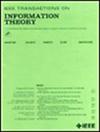Binary Error-Correcting Codes With Minimal Noiseless Feedback
IF 2.2
3区 计算机科学
Q3 COMPUTER SCIENCE, INFORMATION SYSTEMS
引用次数: 0
Abstract
In the setting of error-correcting codes with feedback, Alice wishes to communicate a k-bit message x to Bob by sending a sequence of bits over a channel while noiselessly receiving feedback from Bob. It has been long known (Berlekamp, 1964) that in this model, Bob can still correctly determine x even if具有最小噪声反馈的二进制纠错码
在带有反馈的纠错码设置中,Alice希望通过信道发送一串比特,同时无声地接收Bob的反馈,从而将k位的消息x传递给Bob。人们早就知道(Berlekamp, 1964),在这个模型中,即使Alice的$\approx \frac {1}{3}$位被反向翻转,Bob仍然可以正确地确定x。这改进了没有反馈的经典设置,其中错误分数超过$\frac {1}{4}$是不可能恢复的。在相应的擦除而不是位翻转设置中,反馈提高了从$\frac {1}{2}-\epsilon $到$1-\epsilon $的任何$\epsilon \gt 0$的容错性。最初的反馈设置假设在发送每个比特后,Alice(通过反馈)知道Bob收到了什么比特。在这项工作中,我们的重点是有限反馈模型,其中Bob只允许在协议中预先指定的少数点上发送几个比特。对于任何期望的$\epsilon \gt 0$,我们构建了一个编码方案,该方案仅依赖于Bob在固定的$O_{\epsilon } (1)$轮数中发送的$O_{\epsilon } (\log k)$位反馈,它可以容忍$ 1/3-\epsilon $部分的位翻转(分别是$1-\epsilon $部分的擦除)。我们用一个匹配的下界来补充这一点,表明$\Omega (\log k)$位反馈对于从超过$1/4$的错误分数中恢复是必要的(分别为$1/2$对于擦除),并且对于能够恢复$1/3-\epsilon $位翻转分数(分别为$1-\epsilon $分数擦除)的方案,轮数必须增长为$\epsilon \to 0$。
本文章由计算机程序翻译,如有差异,请以英文原文为准。
求助全文
约1分钟内获得全文
求助全文
来源期刊

IEEE Transactions on Information Theory
工程技术-工程:电子与电气
CiteScore
5.70
自引率
20.00%
发文量
514
审稿时长
12 months
期刊介绍:
The IEEE Transactions on Information Theory is a journal that publishes theoretical and experimental papers concerned with the transmission, processing, and utilization of information. The boundaries of acceptable subject matter are intentionally not sharply delimited. Rather, it is hoped that as the focus of research activity changes, a flexible policy will permit this Transactions to follow suit. Current appropriate topics are best reflected by recent Tables of Contents; they are summarized in the titles of editorial areas that appear on the inside front cover.
 求助内容:
求助内容: 应助结果提醒方式:
应助结果提醒方式:


